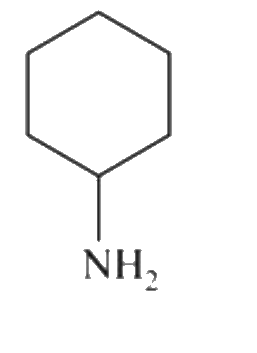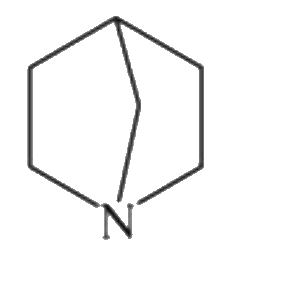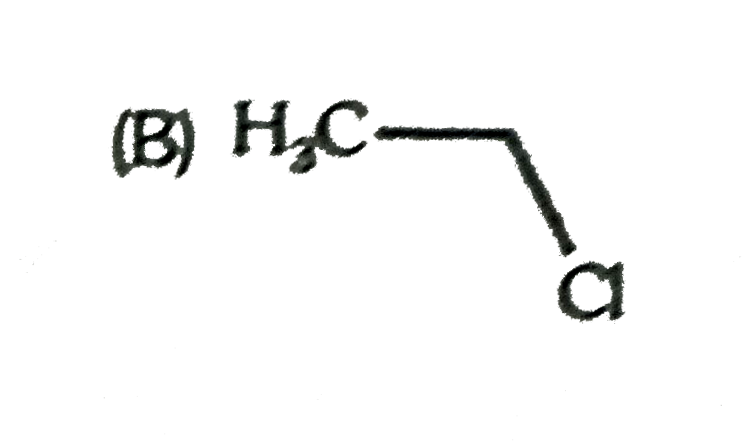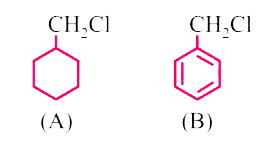In the reaction with aq. Sodium hydroxide which of the following compounds was undergo inversion and SN2 mechanism?


(C2H6)2CHCI
(CH3)3CI
The correct Answer is:A
To determine which compound undergoes inversion and follows an SN2 mechanism when reacting with aqueous sodium hydroxide (NaOH), we need to analyze the characteristics of the SN2 reaction mechanism.
1. Understanding the SN2 Mechanism:
- The SN2 mechanism involves a nucleophile attacking the electrophile in a single concerted step, leading to the inversion of configuration at the carbon atom. This is because the nucleophile attacks from the opposite side of the leaving group.
2. Identifying the Degree of Carbon:
- The reactivity in SN2 reactions is influenced by the degree of substitution of the carbon atom attached to the leaving group (in this case, a halide).
- SN2 reactions are fastest with primary (1°) alkyl halides, followed by secondary (2°) alkyl halides, and are very slow or non-existent with tertiary (3°) alkyl halides due to steric hindrance.
3. Analyzing the Given Compounds:
- We need to look at the options provided and identify the degree of the carbon atom bonded to the leaving group (e.g., Cl).
- If the compound is a primary alkyl halide, it is likely to undergo SN2 with inversion.
- If it is a secondary alkyl halide, it may also undergo SN2 but with less efficiency compared to primary.
- Tertiary alkyl halides will not undergo SN2 due to steric hindrance.
4. Selecting the Correct Compound:
- Upon reviewing the options, we identify the compound that has a primary carbon attached to the leaving group.
- This compound will be the one that undergoes inversion and follows the SN2 mechanism effectively.
5. Conclusion:
- The correct answer is the compound that has a primary carbon atom attached to the halide, as it will undergo SN2 mechanism with inversion when reacted with aqueous sodium hydroxide.
Final Answer:
The compound that undergoes inversion and follows the SN2 mechanism is the one with a primary carbon atom attached to the leaving group.
---
- The SN2 mechanism involves a nucleophile attacking the electrophile in a single concerted step, leading to the inversion of configuration at the carbon atom. This is because the nucleophile attacks from the opposite side of the leaving group.
- The reactivity in SN2 reactions is influenced by the degree of substitution of the carbon atom attached to the leaving group (in this case, a halide).
- SN2 reactions are fastest with primary (1°) alkyl halides, followed by secondary (2°) alkyl halides, and are very slow or non-existent with tertiary (3°) alkyl halides due to steric hindrance.
- We need to look at the options provided and identify the degree of the carbon atom bonded to the leaving group (e.g., Cl).
- If the compound is a primary alkyl halide, it is likely to undergo SN2 with inversion.
- If it is a secondary alkyl halide, it may also undergo SN2 but with less efficiency compared to primary.
- Tertiary alkyl halides will not undergo SN2 due to steric hindrance.
- Upon reviewing the options, we identify the compound that has a primary carbon attached to the leaving group.
- This compound will be the one that undergoes inversion and follows the SN2 mechanism effectively.
- The correct answer is the compound that has a primary carbon atom attached to the halide, as it will undergo SN2 mechanism with inversion when reacted with aqueous sodium hydroxide.
The compound that undergoes inversion and follows the SN2 mechanism is the one with a primary carbon atom attached to the leaving group.
Similar Questions
Knowledge Check
Which of the following compound will not undergo amine inversion?
A BCH3−NH−CH3CNH3D
BCH3−NH−CH3CNH3D
Which one of the following compounds most readily undergoes substitution by SN2 mechanism ?
ACH3−CH2−ClB(CH3)2C−H ∣ CH−Cl ∣ CH3CCH3−CH−Cl ∣ C2H5DCH3−CH3∣C∣C2H5−ClWhich one of the following compounds most radily undergoes substitution by SN2 mechanism?
A B
B C
C D
D
Which of the following compound is most rapidly hydrolysed by SN1 mechanism?
View SolutionIn which of the following compounds hydrolysis tkes plcae through SN1andSN2 mechanism respectively?
View SolutionWhich of the following undergoes nucleophilic substitution exclusively SN1 mechanism?
View Solutionwhich of the following alkyl halide undergo rearrangement in SN2 reaction?
View SolutionWhich of the following compounds will react with sodium hydroxide solution in water ?
View Solution


